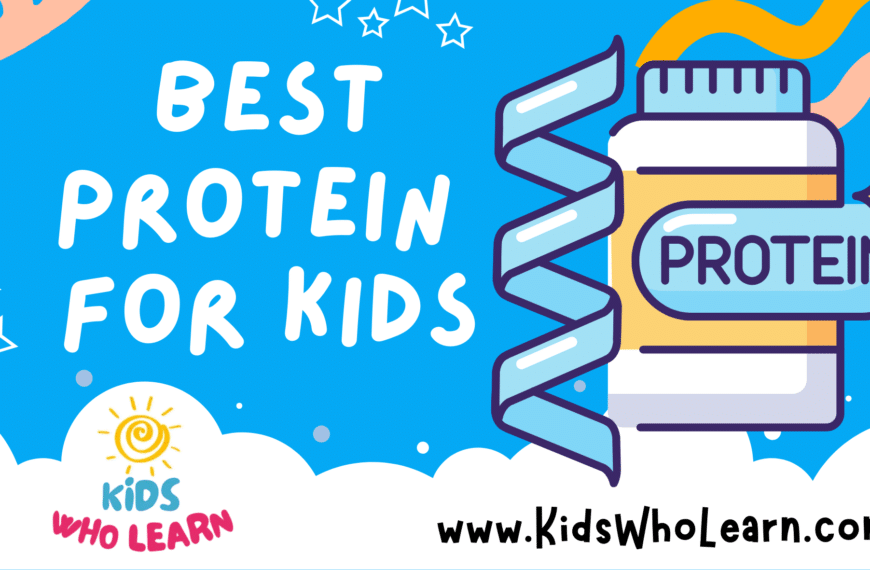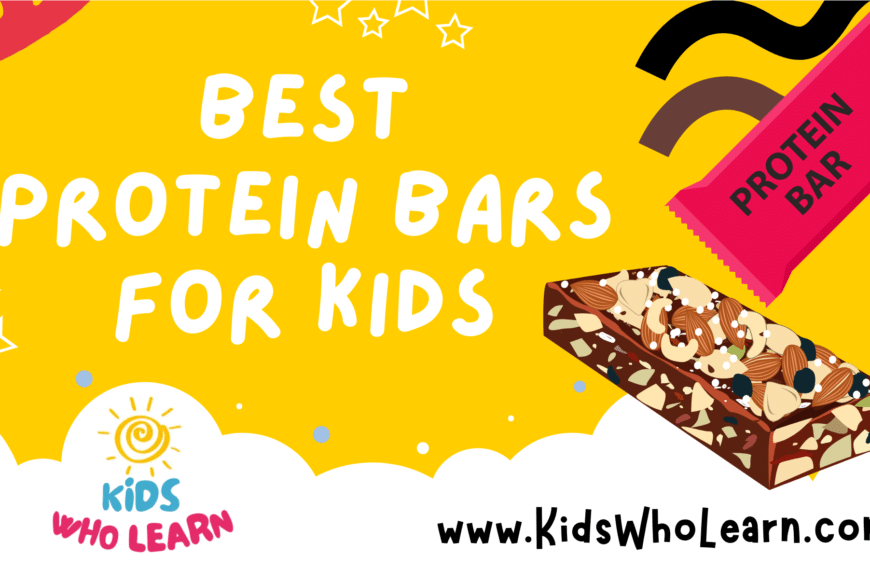Choosing the right foods for kids is vital in laying the foundation for their growth, developing healthy eating habits, and ensuring they have the energy to learn and play. Children have specific nutritional needs that differ from adults, and meeting these requirements is crucial for their physical and mental development. A diet rich in fruits, vegetables, whole grains, proteins, and dairy provides the necessary vitamins, minerals, and other nutrients that children require for optimal health.
As a parent or caregiver, it’s important to plan balanced meals that are enticing and nutritious for kids, while also considering healthy snacking as an integral part of their daily food intake. Involvement in meal preparation can be a fun and educational experience that encourages children to try new foods and understand the importance of nutrition. Additionally, for kids with special dietary considerations, such as food allergies or intolerances, tailoring their meals to meet these needs is essential for their well-being.
Key Takeaways
- A child’s diet should be nutrient-rich and tailored to their developmental needs.
- Healthy snacking and balanced meals contribute to a child’s overall well-being.
- Involving children in meal preparation promotes better eating habits.
Nutritional Requirements for Children
Meeting the nutritional requirements for children is essential for their growth and development. Ensure that your child’s diet includes a variety of nutrient-dense foods to support their health and well-being.
Importance of Vitamins and Minerals
Your child needs vitamins and minerals to ensure proper development and function. Vitamin A is crucial for eye health and immune function. Good sources of vitamin A include carrots, sweet potatoes, and spinach. Vitamin D, obtained from exposure to sunlight and foods like fish and eggs, aids in calcium absorption, vital for bone growth. Vitamin E, an antioxidant found in nuts and seeds, protects cells from damage. Iron is necessary for blood production and can be found in lean meats and beans. Ensure that your child’s diet includes a mix of these essential nutrients.
Proteins and Healthy Fats
Proteins are the building blocks of your child’s body, necessary for the growth and repair of cells. Sources of high-quality protein include chicken, fish, eggs, and legumes. Healthy fats, particularly essential fatty acids found in fish, nuts, and seeds, are crucial for brain development and nutrient absorption. Peanut butter is a kid-friendly source of protein and healthy fats.
Understanding Carbohydrates
Carbohydrates provide your child with energy. Emphasize complex carbohydrates, such as fibers and whole grains, for sustained energy and digestive health. Options like oatmeal, brown rice, quinoa, and wild rice are excellent choices that offer both energy and necessary nutrients.
Role of Dairy in Growth
Dairy products like milk, yogurt, and cheese are rich in calcium, which is fundamental to your child’s bone and teeth development. Serving appropriate portions of these foods can help meet your child’s dairy requirements, contributing to their overall growth and development.
Planning Balanced Meals for Kids
Creating a diet for children that is rich in nutrients yet appealing to their taste buds is no small feat. It’s essential to focus on diversifying their intake while ensuring they receive what their growing bodies require.
Incorporating Fruits and Vegetables
To boost overall nutrition, aim for a rainbow of colors on your child’s plate. Include spinach or carrots for vitamin A, while cherry tomatoes and red bell peppers offer vitamin C. For convenient snacking, keep celery and apple slices accessible. Aim for at least 5 servings per day, with a focus on variety to cover the range of vitamins and minerals they provide.
- Examples:
- Breakfast: Fresh fruit salad with apples and berries.
- Lunch: Carrots and celery sticks with hummus.
Selecting Whole Grains and Legumes
Whole grains and legumes are full of fiber and essential nutrients. Opt for whole-wheat bread instead of white and choose brown rice over white. Beans and lentils are not only rich in protein but also help maintain healthy digestion. Check nutrition labels for fiber content to guide your choices.
- Examples:
- Snack: Air-popped popcorn (a whole grain).
- Dinner: Quinoa or brown rice with beans as a side dish.
Choosing Lean Meats and Alternatives
Provide your child with lean protein sources like grilled chicken, tuna, or tofu. Seafood twice a week can offer beneficial omega-3 fatty acids. Lean meats, as well as plant-based options like lentils and chickpeas, are excellent alternatives to high saturated fat and sodium options.
- Examples:
- Lunch: Turkey sandwich on whole-wheat bread.
- Dinner: Baked tuna patties with a side of steamed veggies.
Avoiding Processed Foods and Sugars
Highly processed foods often contain unhealthy amounts of added sugar, sodium, and saturated fats. Instead of offering hot dogs, burgers, cakes, or ice cream, which are calorie-dense with low nutritional value, prepare home-cooked meals where you can control the ingredients. Teach your child to understand nutrition labels to recognize products with added corn syrup or other sweeteners and choose healthier alternatives.
- Examples:
- Avoid: Fast food items and sugary cereals.
- Choose: Homemade oatmeal cookies with minimal added sugar.
Healthy Snacking for Kids
When choosing snacks for kids, it’s essential to offer a variety of options that are not only tasty but also nutritious. Balancing portions and ensuring a mix of food groups can contribute to a healthy diet.
Fruit and Veggie Snacks
- Apples: Offer apple slices with a tablespoon of almond butter for a dose of fiber and protein.
- Veggie Tacos: Fill mini whole-wheat tortillas with shredded carrots, peas, and a sprinkle of cheese for a fun and nutritious snack.
Vegetables (1 cup portions)
| Vegetable | Serving Method |
|---|---|
| Peas | Steamed or raw |
| Carrots | Sticks with hummus |
Fruits (1/2 cup portions)
| Fruit | Serving Method |
|---|---|
| Apples | Sliced with nut butter |
| Banana | Fresh or dried slices |
Protein and Energy Bars
- Nuts and Seeds: Homemade bars with nuts and sunflower seeds can be both delicious and energy-boosting, always mindful of the child’s portion size (about a handful).
- Registered Dietitian-Approved Bars: Look for bars recommended by dietitians that contain low sugar and high protein.
Energy Bars
- Homemade nut bars (no more than 2 ounces)
- Dietitian-recommended bars with less than 5g of sugar
Whole Grain Options
- Popcorn: Air-popped popcorn is a whole-grain, fiber-rich snack; 3 cups is a good serving size for a snack.
- Cereals and Crackers: Choose whole-grain cereals like Cheerios or whole-grain crackers; opt for a 1-ounce portion to control calories and sugar content.
Whole Grain Snacks
| Snack | Portion | Notes |
|---|---|---|
| Popcorn | 3 cups | Air-popped, lightly salted |
| Crackers | 1 ounce | Whole grain, low sodium |
| Cheerios | 1 ounce | Plain, served with or without milk |
Remember to adjust portions according to the child’s age and appetite, and encourage water instead of sugary drinks to accompany snacks.
Special Dietary Considerations
When feeding your children, it’s essential to consider any dietary restrictions they may
Involving Kids in Meal Preparation
Inviting your children to join in meal preparation equips them with valuable skills and encourages a broader palate. It’s an investment in their health and your family time.
Teaching Nutritional Values
Providing your children with knowledge about nutrients and vitamins is essential for their growth and development. Explain the benefits of ingredients as you cook together. For instance, when preparing a kid-friendly dinner, highlight that carrots are rich in vitamin A, which is good for their eyesight, and whole grains in bread contribute to sustaining their energy levels throughout the day.
- Vitamin A: Found in carrots, sweet potatoes, spinach
- Vitamin C: Abundant in oranges, strawberries, bell peppers
- Whole Grains: Present in brown rice, whole wheat bread, oatmeal
Kid-Friendly Cooking Activities
Incorporate tasks suited to their age and skill level. Stirring the mix for healthy turkey chili allows them to be a part of creating a wholesome meal. Measuring ingredients both teaches them math skills and the importance of portion control. Simple tasks like washing vegetables and setting the table give them a sense of contribution and teamwork.
- Ages 3-5: Washing vegetables, stirring batter
- Ages 6-8: Measuring ingredients, simple cutting with supervision
- Ages 9-12: Following a simple recipe, using kitchen appliances under guidance
Encouraging New Foods
Involvement in cooking can pique interest in trying new foods. If children have a role in preparing a dish, they are more likely to sample it. Offer choices and let them select a new vegetable to add to the meal. This can transform mealtimes into explorative sessions where the whole family engages in tasting new dishes together, such as adding a new type of bean to the turkey chili for a different flavor and nutritional profile.
- Introduce new foods: Gradually, coupled with familiar ones
- Offer choices: Allow them to pick a new vegetable or grain
- Positive reinforcement: Praise their willingness to try new foods
Consulting Nutrition Professionals
When considering the best food for your children, it’s essential to seek expert advice to ensure their meals contribute positively to their growth and development. Here, we’ll discuss when and why you should involve a registered dietitian and continue communication with health care providers.
When to Contact a Registered Dietitian
Parents play a crucial role in setting the foundation for healthy eating habits. If you’re unsure about your child’s nutritional needs, a registered dietitian can provide personalized guidance. You might want to reach out for professional dietary advice in the following scenarios:
- Your child has special dietary needs or food allergies.
- You observe symptoms that may indicate nutritional deficiencies.
- Your child is experiencing unusual weight gain or loss.
- You want to develop a meal plan that supports your child’s active lifestyle or growth spurts.
| Reasons to Contact a Dietitian | Description |
|---|---|
| Nutritional Deficiencies | To address potential signs of inadequate nutrition. |
| Weight Concerns | For professional advice on managing weight healthily. |
| Special Dietary Needs | Tailoring a diet to cater to allergies or intolerances. |
| Growth Support | Ensuring diet aligns with the child’s developmental stage. |
Follow-Up with Health Care Providers
Continual follow-up with a health care provider ensures that your child’s diet remains aligned with their changing needs during key growth periods. Regular check-ups allow you to:
- Monitor your child’s development and adjust their diet as recommended.
- Address any emerging health concerns that could be affected by nutrition.
- Reinforce the advice given by a registered dietitian with your health care provider’s insights.
By consulting with both dietitians and other health care providers, you can create a comprehensive nutritional plan that supports your child’s overall well-being.
Healthy Meal Ideas for Kids
Providing your children with meals that are rich in nutrients is essential for their growth and development. The following ideas incorporate a balanced mix of proteins, vegetables, and other healthy foods tailored to fulfill their dietary needs.
Breakfast
- Oatmeal: Start your child’s day with a warm bowl of oatmeal, which is high in fiber and can be topped with fresh fruits for added vitamins.
- Eggs: Scrambled or boiled, eggs are an excellent source of protein and can be paired with whole-wheat toast for a nutritious breakfast.
Lunch
- Sandwiches: Create a sandwich using whole-wheat bread, lean turkey, and a slice of cheese, along with lettuce and tomatoes for a nutritious lunch.
- Peanut Butter: Spread peanut butter on whole-wheat bread and serve with apple slices to include healthy fats and protein in your child’s lunch.
Dinner
- Veggie Tacos: Assemble tacos with a variety of grilled vegetables and black beans to ensure a meal rich in nutrients and fiber.
- Meatloaf: A classic meatloaf made with lean ground meat and mixed vegetables can provide a comforting and protein-packed dinner option.
- Orange Chicken: Serve a portion of orange chicken with a side of steamed broccoli to combine lean protein with vitamins from vegetables.
Tips for Eating Out with Kids
When dining out with children, prioritizing healthy choices and appropriate portions makes the experience enjoyable and nutritious.
Choosing Nutrient-Dense Options
Select nutrient-dense foods to ensure your children get valuable vitamins and minerals from their meals. Look for menu items that contain a variety of the following:
- Fruits and vegetables
- Whole grains
- Lean protein sources (like grilled chicken or fish)
- Legumes (beans and lentils)
When you choose these foods, your family time is not only fun but also contributes to your children’s well-being.
Understanding Portion Sizes
Restaurants often serve larger portions than necessary. Keep the following in mind to manage portion sizes:
- For children under 4: Serve about 1 to 4 ounces of grains, 1 to 4 ounces of protein, and small pieces of fruit and vegetables.
- For older children: Aim for about 4 to 6 ounces of grains and protein, with half the plate filled with fruits and veggies.
Remember, you can also share meals or pack part of it to go, ensuring your children receive the right amount without overeating.
Educating Children on Healthy Eating Habits
Teaching your children about healthy eating habits is crucial for their growth and development. Focus on making mealtime educational and engaging, and remember that as a parent, you embody their primary model for behavior.
Incorporating Teachable Moments
Use snack time as an opportunity to talk about the nutrients foods contain and why they’re important. A simple chart can be a great visual aid to help children understand what vitamins and minerals do for their body.
| Nutrient | Benefits for Growth & Development | Common Snack Foods |
|---|---|---|
| Protein | Builds and repairs tissues | Cheese, yogurt, nuts |
| Calcium | Essential for bone health | Milk, fortified orange juice |
| Iron | Important for red blood cells | Spinach, beans |
| Vitamin C | Supports immune system health | Strawberries, bell peppers |
When discussing probiotics, explain they are beneficial bacteria found in yogurt and fermented snacks, aiding digestion and improving gut health.
Setting an Example
You should strive to show children what healthy eating looks like. Include a variety of foods in your own diet and make mealtimes a family time to enjoy a range of dishes rich in necessary nutrients. This establishes a routine that reinforces good eating habits.
When you sit down as a family, eat the same healthy foods you offer to your children. Emphasize the enjoyment of taste and the feeling of fullness from eating wholesome foods instead of processed snacks. Make a habit of discussing where foods come from and the role they play in maintaining a healthy body, using clear and literal language to make these concepts accessible.
The Role of Physical Activity
Physical activity is crucial for the growth and development of children. It affects their nutritional needs, including the consumption of calories and protein, and provides valuable family time.
Exercise and Nutritional Needs
When you incorporate regular exercise into your child’s routine, the demand for energy increases. Your child’s body will require more calories to fuel the extra activity. Here’s a brief guide on how exercise affects nutritional needs:
- Calories: Vigorous physical activities heighten caloric needs. Kids who are active will burn more calories, which need to be replenished with nutrient-rich foods.
- Protein: Crucial for muscle repair and growth, active children need a good amount of protein. Recommended protein intake varies, but a balanced diet often meets these needs.
| Age Group | Daily Caloric Needs* |
|---|---|
| 4-8 years | 1,200-2,000 calories |
| 9-13 years | 1,600-2,600 calories |
* Depends on the child’s level of physical activity, size, and growth rate.
Fun Family Fitness
Involving the entire family in fitness activities can strengthen bonds and establish lifelong healthy habits. Consider these options:
- Weekend bike rides or hikes
- Family dance-offs or active games
- Participating in charity runs or walks together
Remember, when planning family activities, tailor them to be enjoyable for everyone, ensuring that each member of the family stays eager to participate. Prioritize fun to keep the motivation high.
Monitoring Growth and Development
Ensuring your child’s growth and development proceeds optimally involves regular assessments and mindful tracking of dietary intake. These measures allow you to respond to your child’s changing needs effectively.
Regular Health Check-ups
You should schedule regular health check-ups with your pediatrician. These visits provide an opportunity to assess your child’s growth patterns compared to standardized growth charts and developmental milestones. The growth parameters usually evaluated include:
- Weight: Ensures the child is gaining an appropriate amount of weight for their age.
- Height: Tracks the child’s stature growth, which can indicate overall health.
- Head Circumference: Helps assess brain development, particularly in infants.
During health check-ups, your health care provider may give personalized advice based on your child’s growth trajectory. Additionally, if growth or developmental delays are identified, they may refer you to a specialist, such as a dietitian, for further guidance.
Tracking Nutritional Intake
Maintaining a meticulous record of your child’s nutritional intake is vital. It’s important to ensure your child receives the necessary nutrients and calories for healthy development. Consider the following elements in your child’s diet:
- Proteins: Key to building muscle and repairing tissues.
- Carbohydrates: Provides energy for growth and play.
- Fats: Essential for brain development and supplying energy.
- Vitamins and Minerals: Crucial for overall development and preventing deficiencies.
Track your child’s meals using a simple chart:
| Meal Time | Foods Consumed | Nutrients Provided |
|---|---|---|
| Breakfast | Example: Oatmeal, Banana | Carbs, Fiber, Potassium |
| Lunch | Example: Turkey sandwich, carrot sticks | Protein, Vitamins A and C |
| Dinner | Example: Grilled chicken, broccoli | Protein, Vitamins C and K |
If you’re unsure about your child’s dietary needs, consult with a dietitian who can offer tailored advice on creating balanced meals suitable for your child’s age and activity level. They can also help you understand portion sizes and the balance of food groups within your child’s diet.
Addressing Picky Eating
Picky eating can be a significant challenge for many parents, impacting not just mealtimes but also the nutritional intake of children. Successfully introducing a variety of healthy foods, including fruits and vegetables, requires patience and strategy.
Strategies for Diverse Diets
Consistency is Key: You can’t expect children to enjoy new foods overnight. Regularly introduce new foods alongside familiar favorites to help them become more comfortable with variety.
- Offer Choices: Giving children a say in their meals can empower them. You might present two vegetable options and allow them to select one.
- Make It Fun: Turning meal preparation into a game can pique a child’s interest. For example, you could arrange vegetables into a smiley face on their plate.
- Involve Kids in Cooking: Allowing children to help with meal preparation can increase their interest in eating the foods they helped create.
- Serve Small Portions: Introduce new foods in small quantities so they’re less intimidating, and children can try them without feeling overwhelmed.
Encouraging Positive Associations
Positive Reinforcement Works Wonders: Praising children for trying new foods can reinforce good eating habits. Focus on the behavior, not the amount eaten, to build confidence and interest in trying new foods again.
- Avoid Food as a Reward: Using dessert as a reward for eating vegetables can create negative associations with the healthier food. Instead, praise the act of trying something new as its own triumph.
- Family Mealtimes Matter: Eating the same foods together at the table makes kids more likely to try and enjoy new foods. It sets a healthy example and establishes mealtime as a shared, positive experience.
Frequently Asked Questions
Navigating your child’s nutrition can be complex, but focusing on a diet rich in fruits, vegetables, whole grains, and lean proteins is a reliable path to optimizing their growth and health.
What are the ideal nutritional foods for a child’s optimal growth?
Your child’s growth depends greatly on a balanced intake of nutrients. Foods like lean meats, dairy, fruits, vegetables, and whole grains are essential for providing the vitamins, minerals, and energy necessary for optimal growth.
How can parents ensure a balanced whole food diet for their children?
To ensure your children are getting a balanced whole food diet, incorporate a variety of fresh produce, whole grains, and lean proteins into their meals. Planning meals and being a role model by choosing healthy foods yourself can significantly influence their choices.
What are the top ten healthiest foods recommended for child nutrition?
The top ten healthiest foods for children include: leafy greens, fresh fruits, whole grains, nuts, lean meats like chicken or fish, yogurt, eggs, legumes, milk, and seeds. These foods are rich in essential nutrients that are pivotal for a child’s health and development.
How do you explain the importance of healthy eating to a child?
You can explain the importance of healthy eating by relating foods to their benefits, such as stronger bones from calcium-rich foods or better vision from eating carrots. Make the conversation engaging and age-appropriate to help them understand the connection between food and wellbeing.
What are some creative and healthy food ideas for a children’s party?
Consider fun and healthy food options like fruit skewers, yogurt dips, whole-grain crackers with cheese, and vegetable sticks. Turning healthy snacks into visually appealing shapes or characters can make them more enticing to children at a party.
How can a parent encourage their child to eat healthily according to government nutrition guidelines?
Parents can encourage healthy eating by offering a range of nutrient-dense foods consistent with government guidelines, such as MyPlate in the United States. Involve your children in meal planning and cooking to teach them about nutrition and to help them develop healthy habits.










